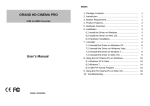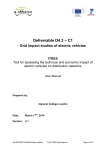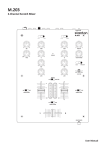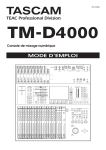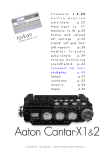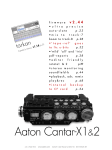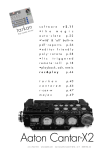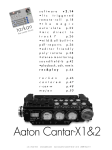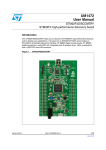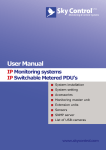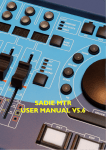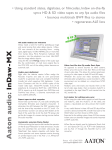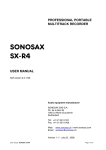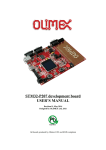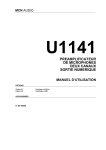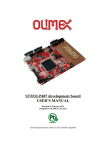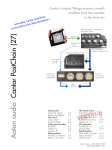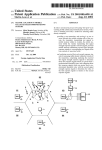Download Aaton audio: Cantar
Transcript
download Cantar PostChain from www.soft.aaton.com/swcantar, read ‘keep in touch’ and ‘version history’ last page. Ergonomics : v1.12 Arcan tings, rou input graphs, a b k r . 8 trac me entries a ) n k m c o a .c r t aton .a t f o .s (www Backward/Forward Scrub 18 LTC-out frame rate 18 Browse All days 19 All projects 19 Permanently accessible faders 2 Displays Xtra channel bargraphs 3 Modulometers 3 Inputs to tracks routing 3 Pan-pots 4 Mon-outs routing 4 Inputs to tracks Primary & Xtra channels 20 MS channel declaration 21 Create & Modify 21 Channel (dis)arming 21 IMon-outs Monitoring banks 22 Check & create grids 22 Aes in-out powering 23 Manual command Twelve pos. main selector 5 Three-crown-turret 5 Push buttons 6 Keyboard 6 Aaton audio: Cantar v1.54 Power Audio Battery check 7 Mini/Maxi Voltages 7 Li-Ion management 7 Tone & slate 24 Xa Xb routing 24 Precord adjust 25 Mic Preamp ganging 25 Rec.run and Operator TC 25 new Filing Project name 8 Working day 8 File names with Filetags 8 Tech Time Calendar clock 9 Sync clock tutorial 9 Sync clock inits 10 Aes auto re-cloking 11 Fps and sampling rates 11 new Test Session Connect inputs 12 Dynamic & Phantom mics 12 Limiter, filters, attenuator 12 Mic Coupling 13 Channel (dis)arming 13 Project name 28 Hdd int., ext. or both 28 Format, disk-scan 29 Delete a file 29 Backup PPR new Pre-record buffer 14 Enter-edit Sc & Tk IDs 14 Enter track names 14 File shortening 15 Last file erasing 15 Rec Modulometers 16 Instant solos 16 Pan-pots 16 MixDown 16 Tone gen. & Slate mic 17 Warning beeps 17 Headphones level 17 Unmount Hdd 26 Calendar reset 26 Pda connect 27 Save / Load user’s setup 27 Temp compensation 27 Software install 27 new Idle backup 30 Short/Long Filenames 30 All Master tracks+Mix 30 DVD±R, DVD-Ram 31 Backup w/. laptops 31 Tutorials Surround 5+1 32 Labeling DVDs 32 Video cameras w/. GMT-s 33 Sound report w/. Majax 33 Slate sync w/. Indaw 33 Connectors Audio in/out, Accessories 34 Play Files of the day 18 Play-marks 18 Cantar v1.54 User Manual 2006 Jan 09 p.1 ERGONOMICS 9 permanently active ‘no trim’ prefaders ote A remntrol co n -scree touch here it w be: must rowell p the in tected hand 6 permanently active mixer postfaders Xa Xb channels on 2 linear modulos Permanently accessible nine rotary prefaders plus six linear postfaders devoted to one specific task each. C1 to C6 channels on 6 circular modulos files A1 to A8 The Cantar interface is the easiest to use in the most difficult missions. • because the largest display surface of all portable recorders simultaneously show every critical recording parameter. • because the custom designed high contrast LCD displays remain visible under bright sunlight, and at very low temperatures too; and because the swivelling front panel always offers the best viewing angle for both cart and shoulder work. • because the large twelve position main selector eliminates deep diving into sub-directories, and because the unique three-crown turret gives instant access to all recording and monitoring configurations, even with gloves on. • because nine rotary prefaders plus six linear postfaders each entirely devoted to one specific task give more possibilities and are faster to handle than four multi-function knobs... Cantar v1.54 User Manual 2006 Jan 09 p.2 DISPLAYS 1 of 2 Rectangular Thanks to the X&D panel and the twelve position main selector, there is no sub-menu deep diving on Cantar. Circular 1 Xa 1 Xb Six primary channels Modulometers C3 C4 C1 C2 2 C5 C6 3 In TEST / REC line 1 shows the XaXb channel levels (most of the time the mixer output) on linear bargraphs. Rotating the jog replaces the bargraphs by the battery voltage, the available recording time, and the remaining disk space... then back to bargraphs. line 2 shows the sync-clock initialization source, Atc (Ascii from Origin-C), Ltc (jam from an LTC gen.), Stc (taken from the system calendar), OTC (operator entered TC), Rtc (Rec.Run mode), and Etc (permanently slaved by an external clock). The time is the one stamped in the audio file. line 3 shows the filetag and duration of the take, or by [Shift+ eye] the Sc & Tk IDs. In PPR the screen is used to monitor scene, take and notes entries (see PPR chapter). In Technical Positions the pathtree of each value shows: •chapter e.g. AUDIO on line 1 •parameter e.g. Sample rate on line 2 •value e.g. 48K on line 3. Cantar’s large circular modulometers, visible in bright sun as well as in the dark, are the most accurate (1dB) metering tools found in any portable recorder. Fifteen Inputs to tracks routing C3 C4 C1 C2 mic 1&2 mic 3&4 C5 C6 line 1&2 The six primary channels receive any one of the 15 inputs: line 1 2 3 4, mic 1 2 3 4 5, aes 1 2 3 4 5 6. The ins-tracks grids created and stored by the operator are instantly recalled, just press the swiveling panel top left routing button, and rotate the config crown to the desired grid : a one hand operation! The picture shows : mic1 to channel-1, mic2 to channel2..., line1 to channel-5 and line2 to channel-6. The construction of the input/track routing grids is explained in the INS:TRACK chapter. Cantar v1.54 User Manual 2006 Jan 09 p.3 DISPLAYS 2 of 2 Incremental pan-pots Ancillary controls The Solo-Mix-Pan switch being on ‘pAn’ (bAttery side), press one of the linear fader control button: the left/right pan of this channel goes under control of the jog wheel, the exact numerical values (in dB) show on the XaXb screen. All the channel pan-pot positions simultaneously appear on the three screens. The 3-platter icon of the int. hdd shows on the left screen, the 3-platter icon of the ext. hdd on the center, the 1-platter icon of the burner on the right. The disk activity is hilited by the channel black squares near the concerned disk icon. The int. or ext. clock selection, the mic phantom power, the mic phase (direct or invert), the mic limiter activation permanently show here too. Mon-outs left ear center right ear The three circular screens show the channels sent to the left outputs on the left screen, channels sent to the right outputs on the right screen and channels sent to both in the center. The same rule applies for headphones, lineout, foldback and AES-out. Note that all inputs can also be directly routed to the outputs without going through a recording channel, e.g. line3 in the given example. On the pict, channel 5 goes to the left, channels 1&2 go to the center, channel 6 goes to the right as does line3. The main-selector central button makes the current Mon-outs grid show up. The Config crown opens instant access to twenty six independant banks (see MON-OUTS). Cantar v1.54 User Manual 2006 Jan 09 p.4 REC BACKUP PPR TEST SELECTORS SESSION STOP TECH AUDIO PLAY ROUTE.INS BROWSE MON.OUTS The main selector Note: the phones receive an audio signal which is identical to the one of the output under configuration setting. Six ‘sound managing’ positions •REC •PPR •TEST •STOP •PLAY •BROWSE, laid in the standard way. Config crown Easy to manipulate even with gloves on. Six ‘operand’ positions •MON-OUTS •ROUTE-INS •AUDIO •TECH •SESSION •BACKUP, give access to all the possible settings of the machine. Three buttons falling under the thumb – a black, a white, and a red –, work with a large blue [shift] key activated by the index. TEST PPR REC [white] shows the mon-outs grid (resets the peak indicator in permanent hold mode). [shift•white] in PPR opens/closes scene editing. [black] sends slate mic to line-out and foldback. [shift•black] sends slate mic to the channels also. [red] toggles the p (PU), w (wild sound) t(sync), n (ignore) take genders. [shift•red] tone generator; tone stays ‘on’ if [shift] is released first. IN PLAY. [white] stops and starts the player from the marker. [black] puts a start marker on the current played position (to make a pause, press [white] then [black]). [shift•black] resets the player to 00. IN ROUTE-INS / MON-OUTS. [black] sets a link point. [red] erases a link point. IN • While in REC, press the mon-outs button (main selector central white button), the monitoring pattern shows on the three circular screens which become a big ‘LeftCenter-Right’ display. Since this doesn’t affect the recording at all, you can onthe-fly listen to and select Monitoring crown another listening pattern by rotating the config crown. In the same way by pressing the routing button top left of the swivelling panel, you can swiftly verify the inputsto-channels configuration in use. To avoid catastrophic finger errors while performing a recording, the current Ins:Track config can’t be modified in REC. But there is a shortcut: by quickly switching to PPR (up to 35 second long), you have plenty of time to select another Ins:Track configuration and go back to REC not losing a single sample of sound! • In TEST and PPR the config crown browses the fifteen Ins:Track configs and activates the latest seen before the routing button is released. Jog crown The ‘one finger’ jog is used to move the cursor in the message panel, edit Scene&Take, select high pass filters, modulate the backlight, control the pan-pots, and scrub the player in fast forward/reverse playback. Note: [Shift•Jog] 10x accelerates the jog speed. The 3-CrownTurret The large all weather 3-CrownTurret give access to all the monitoring grids and input routings. Monitoring crown [1] So: the 5Mic inputs, 4Line-in, 6AES inputs, and active channels SOLOS are sent to the headphones. [2] Ph: mixer output and seventeen user’s grids to the headphones. [3] Lo: mixer and nine user’s grids to dual line-out. [4] Fb: mixer and nine user’s grids to dual foldback. [5] Di: mixer and nine user’s grids to dual digi-out (AES). Cantar v1.54 User Manual 2006 Jan 09 p.5 BUTTONS & KEYS Buttons depth, TC numeration. [shift•esc] opens a help on the M&D bottom line. Mic Pre-faders [1] limiter on/off. [shift•1] phase invert. [2] mic solo, filter selection, balance access. [shift•2] phantom 48V supply activation. [routing] in Rec, shows the current Ins:Track config on the circular displays. The recording is not affected by this command. 3 1 2 [shift•3] links faders 1&2 and 3&4 Channel Post-faders [SoloMixPan+C] pAnpot jog setting. slider on bAttery side: . [SoloMixPan+C] sOlo mOnitoring. slider on operatOr side. Swivelling Panel [batt] selects battery. [shift•batt] in Stop position, switches off the power. [eye] toggles the rightmost display channel 5*6 modulometers to X*X (formerly 7*8). [shift•eye] toggles the 3rd line of the X&D display from Sc&Tk to Filetag. Keeps the last selection as a preference for the working day. During backup operations, it toggles the ‘backup rank’ and the media ‘labels’. [jamtc] for more than 2sec sets the TCXO clock to the LTC entering the Lemo-5 or SubD-15. [shift•jamtc] for more than 2 sec. sets the TCXO sync clock from the calendar time. [arrows] in Play, next file of the day ; in Setting, next topic or parameter ; in Routing, next input. Keyboard On a cart it is easier to enter scene-take IDs and notes with a keyboard. Only use a QWERTY US/English PS/2 compliant keyboard, connect it to the Cantar subD-15 socket through the Aaton «USB>PS2>subD-15» active converter (see Accessories). Cherry Ref: G84-4100 PTM EU (USB/PS2 type plug) www.cherr y.de/english/advanced-line/advanced_g844100.htm Grandtec Virtually Indestructible FLX-500U www.grandtec.com/vik.htm in PPR ‘Sc&Tk’ : with the right arrow, select ‘Scene’ on the M&D display line 2, [enter]. The left/right arrows browse the sc&tk characters, the vertical arrows select the desired value, [enter]. ‘Notes’ : with the right arrow, select ‘Notes’ on line 2, [enter]. The cursor being on line 3, key your notes under the Cantar text editor control, [enter]. in AUDIO, TECH, etc. with the right arrow, or typing the parameter number, select the desired parameter on line 2, e.g. 05 Shmilb [enter], the cursor goes down to line 3, select the parameter value, [enter]. Note: the keyboard [enter] and the Cantar [ok], the keyboard and Cantar [<- ->] have the same action. Cherry G84-4100 [ok] makes the line 2 selected parameter set of values appear on line 3, then acknowledges the selection. [shift•ok] in Play, continuous playback to next file. [esc] shows the file characteristics: sample rate, bit Cantar v1.54 User Manual 2006 Jan 09 p.6 POWER Power supplies Main selector on STOP, press either one of the front panel [batt-1] or [batt-2] button for a couple of seconds. All displays flash and the message panel lights up to confirm that Cantar has started correctly. On the leftmost circular display, the internal disk icon blinks for 3 to 5 seconds, the time it takes for the disk to wake up; it is surrounded by the icons of the currently routed channels. At startup, the message panel shows batt-1 and batt-2 voltage, plus the system day and hour. To shut Cantar down, put the main selector on STOP, maintain pressure on the [Shift] fat blue key then [batt], ‘Goodbye’ shows. Important notice: when in STOP the internal Hdd sleep mode makes the current drain be a mere 270mA. To keep the high stability internal sync-clock reference, do not switch off Cantar during the working day. The sleep mode activation can start one second after STOP, see TECH chapter. The twin battery safety The Cantar low power high efficiency electronics offer the longest working time of all portable 8 channel audio recorders. With a single set of on-board Li-Ion (or NiMH) batteries, the 18 (15) hour Cantar outperforms all others. And with the twin battery system you are never be taken by surprise. While working on a cart from a mains powered supply, keep a battery onboard and activate both inputs: the battery will buffer the possible mains power voltage drops or cable bad contacts; furthermore, Cantar on STOP, moving the cart and unplugging the power cable, it will run the TCXO sync clock for hours. Minimum voltage A battery switch-over is automatically done @300mV below the operator set BattAlert. This allows the use of either 12.5V NiMH batteries with 10.5V switch-over triggering level, or14.4V Li-Ion batteries with 12.4V switchover triggering level. (see TECH-10). A two beep alarm tone is heard and the display shows ‘left/right bat low’. As soon as the power voltage drops under10V, i.e. too low to run the recorder, both inputs are put on-duty. If during a recording you must change a battery, press the two buttons to connect both batteries before you remove the depleted one, this is a good safety measure in case you would unplugg the wrong battery... Maximum voltage 16.6V is the absolute maximum voltage to be applied to all Cantar power sockets. This rule applies to the firewire input socket as well. Never connect G3 G4 G5 MacIntosh desktops, which deliver 30V onto their Firewire output, to the Cantar firewire socket ! To connect a Cantar internal Hdd to a Mac, either use a Mac laptop powerbook which delivers a safe 16V, or extract the Hdd and directly connect it to the Mac desktop (HDDs’ Firewire to Atapi bridges handle 33V). No problem with PC Laptops or Desktops, they deliver a safe 12V. Battery check In TEST the battery voltage is displayed every 10 seconds. This voltage also appears in all positions of the main selector whenever you momentarily press the batt-1 or batt-2 buttons; pressing longer on one of these buttons forces the on-duty battery. Li-Ion battery management The Aaton-R-Cell Li-Ion batteries deliver 30% more power than the equivalent size NiMH batteries at room temperature, and up to 60% more at -20°C; they are lighter too, e.g 560gr vs 695gr for NiMH. Charge To avoid inadvertently connecting these batteries to the many NiMH chargers around, the elements are protected by an 80 Volt reverse voltage diode on pin4 (the active pin of the Ni-MH chargers) and directly connected through pin3 to the Aaton-Mascot Li-Ion charger. When charging Li-Ion batteries, follow this simple rule: ALWAYS unplug the Mascot charger from the mains before connecting or disconnecting a battery. Supply The +Batt. current is delivered either through the low loss (0.2V) diode-protected pin4 of the Li-Ion R-Cell to the pin4 of all known recorders and cameras around, or directly through pin3 to those machines with pin3&4 tied together, i.e. Cantar over #268 (and Cantar w/. 4pin XLR-4), and to the Aaton Super16 XTR2005 or 35mm Penelope cameras. Cantar v1.54 User Manual 2006 Jan 09 p.7 FILE SYSTEM Error-free filing system 3. File Name 1. Project 1- the Cantar auto-incremented six character filetag, e.g. ADC123, differentiates 6.7 million takes... a sound mixer lifetime! It must remain untouched all the way through to the final mix. Note that one filetag represents a complete ‘file group’ recorded during a take, e.g. ADC123 is the unique filetag of eight monophonic files from ADC123_1 to ADC123_8. When you cold-start Cantar, it assumes you want to continue working on your latest project, which is therefore displayed at the bottom of the message panel. When you rent a Cantar, its project memory should be empty; the message panel should read ‘No Project’. Once created, a ‘project name’ regroups all data related to it, such as the days of recording, the channels and the disks used. The project name is stored in each audio file, there is no risk for a file to be lost in a maze of terabytes. Contrary to other machines the Cantar file sorting system doesn’t rely upon disk partitions. Made of Project, Working Day and Filetags, it allows for intuitive and safe retrieving of the audio files along the post-prod chain. It is not operator-error prone. To give a new project a name (eight letters and/or numbers), switch the main selector to SESSION (2 o’clock). Rotate the jog to ‘New Project’, press OK. A triangle points the character to be modified. Run the jog to choose a letter, then press an horizontal arrow to move on to the next letter. Once the full name is entered, press OK. If you are in a pinch and have no time to create a project, directly go to RECORD. Your audio files will be stored in a project called AACANTAR. Later on, with a lap-top you will move these audio files out of AACANTAR, into the project directory you would have created in the mean time. 2. Working Day The ‘working day’ is not related to the actual ‘time-of-day’ as defined by syncing clocks, it is an interpretation of the ‘human’ day (see time next page). The Aaton InDaw, a multichannel digital audio recorder, introduced the Cantar filename system in 1997. It attributes a totally operator independent filetag to each take, it shows some physical characteristics of the file in the filename suffix, and optionally carries an operator entered sc&tk descriptor. The difficulty was to perform these three tasks while keeping compatibility with edl standards which only can handle the ‘8+3’ limited DOS filenames, and the many Mac-OS editing stations which are limited to 31 characters. All this is explained in The PostChain www.soft.aaton.com/swcantar. 2- the suffix instantly flags the monophonic independant files, e.g. _1, _2, ... _8, the polyphonic interleaved file, e.g. P8., and the poly mixdown of the former, e.g. PX. 3- the descriptor shows a summary of the take status and the sc&tk ID, e.g. =a18:2a w04=. A short filename shows as ADC123_1.wav A long file name shows as ADC123=a18:2a w04=_1.wav Note : the Cantar recorded audio files are Monophonic files, i.e. independant files, stored in the ‘working day folder’. Automatically opened by Cantar each working day morning this folder is named by the date, e.g. 20041206. AAD. Since there is a possibility that Cantar itself or Majax interleave the original Monophonic files into a Polyphonic gang for those editing machines which can only handle Polyphonic sounds, there always is a ‘shadow folder’, .AAX suffixed, which carries the polyphonic files –carrying the same filetags – of the same day, e.g. 20041206.AAX. Cantar v1.54 User Manual 2006 Jan 09 p.8 TIME & CLOCKS 1 of 3 Calendar and Sync Time is the essence in a digital audio recorder, two types of time are in use: at the deep level the ‘Calendar time’, at the visible level the ‘Sync time’. One Calendar Clock The calendar time runs for ever (four to six years on a lithium battery) in an always active medium precision clock which automatically creates the day folders in which are stored the audio files of each working day. The calendar day and hour show on the message panel when the main selector is on STOP. The setup of this clock is of primary importance to the file management system. Its time must be checked for coherence (±5 minutes) with the time-zone you are working in. Think about this when you get off a six-hour flight! To modify it, go to the main-selector TECH position select ‘System day and time’, and press OK: a triangle points to the modifiable element. Using the jog, select the desired value, then with arrows move on to the next column, and so on. Press OK to exit. The ‘working day’ is not related to the actual time of day defined by the syncing clock; it is only an interpretation of the ‘human’ day; its duration can be from 6 am in the morning to 3 am in the deep night of the next day. If you switch off the batteries after midnight, Cantar thinks the operator has gone to sleep. But if your ‘working day’ is continued in the wee hours after a midnight snack, you would probably not want it to be considered as a ‘new’ day. That is why Cantar asks ‘start new day?’, giving you the opportunity to decline the offer or say [Yes]. Note that immediatly going to REC is an acknowledge too. Thus, if you stop working at 2am one day, the audio files are still part of the (technically) ‘previous’ day folder. Conversely if you want to start a new working day right after midnight, you only have to switch off the battery and immediatly switch on, then answer [Yes] or go to REC. Three Syncing Clocks At start-up you will no doubt notice a blinking int-c or ext-c icon, depending upon the mode selected in AUDIO-08. This blinking reminds you to sync Cantar to the same time reference as the one running in cameras and audio recorders. To ensure image and sound syncing many different methods are in use, while we prefer the real time ClockA method, some other people work differently, hence the three clock types offered by Cantar. Clock-A: the internal TCXO 1ppm ‘time-of-day’ clock keeps the time with virtually no drift ; this time is used to stamp the sound files to the very same TC as the one stamped onto the images by TCXO equipped cameras. In the video world this is called the free.run mode. Cantar behaves as a master-clock. Clock-B: the internal Cantar clock generates a TC which is two second incremented over the stop-TC of the preceding take. This semi-continuous clocking requires a wired or wireless link to transmit the Cantar generated rec.run timecode to cameras and digislates around. Clock-C: the externally-slaved Cantar clock ensures that sound files are time stamped by the very same tc as the one running in the companion video camera. This requires a wired or wireless link to transmit the Camera generated timecode to Cantar. Next page you will find how to work in these three clocking styles. Cantar v1.54 User Manual 2006 Jan 09 p.9 TIME & CLOCKS 2 of 3 Sync Clock-A internal real time master clock : ‘int-c’ The internal TCXO clock can either be initialized by Cantar itself : - Calendar init. : pressing and holding [Shift] then [TC jam] in that order for more than two seconds pushes the calendar days and hours into the internal TCXO master clock. Stc – system-tc – shows in the message panel. If under high pressure you forget to press [Shift•TC jam], the calendar days and hours are nevertheless used by default. - Operator init. : in case you don’t want to use the system calendar timekeeper, the TCXO clock can be internally set from the time keyed by the operator in AUDIO-18. Otc – operator’s-tc – shows in the data panel. or it can be initialized by a momentarily connected external signal : - LTC init. : pressing [TC jam] for more than two seconds makes a Lemo-5 entered Smpte LTC jam the Cantar TCXO clock. Jtc – jammed-tc – shows in the data panel. If there is no coherent LTC while pressing TC jam, ‘failed’ shows and the int.c icon keeps blinking. - ASCII init. : the TCXO clock is set by an Aaton OriginC used to set Aaton and Arri film cameras, or video cameras recording free-run TC from an Aaton GMT. Atc – ascii-tc – shows in the data panel. In Clock-A mode, Cantar is THE time reference. As soon as the int-c icon stops blinking Cantar is a master clock and generates a TCXO (temperature compensated) 1ppm accurate production timecode for eight hour shooting within +/- one frame accuracy. Switch-on the ‘Ltc generator’ in AUDIO-08. The Ltc-out can be used to permanently sync equipments around through cable or radio transmitter, or to momentarily initialize several Aaton GMT-s low power hi-accuracy time keepers which, attached to video cameras, provide the same date and time as the one running in Cantar now considered as the master clock. Do not power down Cantar Being on a job on which the free.run time-of-day TC is the essence (Aatoncode cameras, HD cameras with GMT reference generators, smart digislates), never power down Cantar during the working day to avoid the loss of its 1ppm reference time! Note that while the internal Hdd is in sleep mode the total power consumption is a mere 270mA! Go to TECH 11 and set the Hdd to sleep one minute after STOP. If you nevertheless want to power down Cantar at lunch time, the blinking int.c icon at powering up will remind you to re-initialize its sync clock and all equipments around. Sync Clock-B internal rec-run master clock : ‘int-c’ In rec.run the real-time no longer exists, there is a two second gap between each take TC. Furthermore the init.TC is directly entered by the operator using arrows and Jog in AUDIO-17. To avoid twice the same TC entries, the rec.run init. menu proposes the next full hour each time it is activated. The rec-run mode does let you use up to 35 sec of Prerecord without creating TC overlaps. The time being arbitrarily generated by Cantar, the LTC-out must be permanently connected to the other sync machines. Note that a freezed LTC is generated while Cantar is on TEST or PPR. Sync Clock-C externally slaved : ‘ext-c’ Select ‘external’ in the AUDIO-08 menu : ext-c blinks in the circular display, meaning that Cantar is waiting to be slaved to an external LTC, e.g. a video camera. Knowing the audio recorder is usually put in REC before the camera sends a correct timecode, while in REC only Cantar monitors the incoming LTC and waits until a coherent TC shows on the Lemo5 or subD-15 to grab it. Thus ext.c keeps blinking until the camera is up to speed. At the end of the take, before closing the audio file, Cantar stamps a TC by using the latest valid timecode so as to eliminate spurious transmission errors and false camera starts. If there is no ext.c LTC a warning in the data panel and a beep are triggered every four sec. The beep is hindered if a take is W (wildsound) tagged, see the PPR ‘scene&take edit’ page. The ext.c is nevertheless grabbed if it shows before the take closure. New file creation on ‘Ext TC’ breaks could be offered but considering the advantages of real time recording, its implementation is postponed: see ‘Cantar and video cameras’ tutorial end of this document. Cantar v1.54 User Manual 2006 Jan 09 p.10 TIME & CLOCKS 3 of 3 AES re-clocking Cantar totally eliminates AES re-clocking worries, the extc choice above only deals with the LTC time used to stamp the audio files, and should not be confused with AES syncing. To eliminate jitter Cantar always works from its internal clock, not from external AES clocks. like other recorders do. Each and every AES input is rephased by its own sample rate converter to the point it is possible to enter non synced AES sources, e.g. from a Yamaha console and an AES mike together. All AES inputs are realigned to an exact non jittering 48k before entering the Cantar routing circuits. There is no need to word-sync AES accessories! Linking two Cantars When recording 16 tracks, two coupled Cantar receive separate analog sources, the sync between the two machine is perfectly ensured by timecode only, there is no need for a word clock. The Cantar TCXO clocks used for the analog to digital sampling are very stable (no measurable jitter) and very precise (1ppm). They ensure better sound clarity than phase locked samplers. There is no shift nor audio ‘phasing’ between the tracks of the two recorders. When it comes to later mix the two sets of tracks, the timecode and sampling rate precision ensures a time difference lower than the time it takes for a sound to travel by ten centimeters! Camera fps & audio-sampling rates The video or film camera frame rate is totally independant of the audio sample rate. But when working with a NTSC SDI or HD video camera the selection of 23.98ND and 29.97ND will also tells Cantar and the Avid composers you are working in the ‘lazzy second world’, and this has an influence on the way the metadata will be recorded into the audio files. What is a lazy second? On Earth, a second is a second, the camera frame rate metadata is a simple remaining, nothing more. The (44.100, 48000 or 96000) sampling rate per earth second is called a sampling frequency. Because of the different Avid softwares the BWF metadata must carry a sample-stamp showing either the real sampling frequency or the number of samples per lazysecond. Please read «Avid-Recording-Rates» by Michael Philips found on www.soft.aaton.com/swcantar/. You will see that two different NTSC sample-stamp methods are used. The recorded sound remains the very same, only the attached ‘metadata’ is different. Universal stamp NTSC or not, the universal sample stamp carries the real number of samples by Earth second, i.e. the ‘sampling frequency’ of the sound. Select [24] [25] [29.97DF] [30] or [23.98ND -.1%B] and [29.97ND -.1%B] in AUDIO-9 page 24. In a file recorded at 48kHz, the stamp will show 48000; recorded at 48.048kHz, it will show 48048. Special Avid stamp (Avid Composers v.11.3.2) The stamp carries the ‘number of samples’ contained in the NTSC lazy second (1.001 Earth second). Select [23.98ND -.1%A] or [29.97ND -.1%A] in AUDIO9 page 24. In a file recorded at 47.952kHz, it will show 48000. Action! When Cantar is set to Ext TC, it will _only_ jam timecode when you go into Record Mode. Otherwise, pressing the TC Jam button on the front panel will get no response from the Cantar. When it is set to Int TC, pressing the TC Jam button will only work if there is valid timecode applied to the TC Lemo input. Pressing and holding the Blue Shift button, and then the TC Jam button (it must be done in that order) will result in Cantar jamming System Time into the internal TC generator, and a “Jam OK!” message will appear on the display screen. On the slow NTSC planet, the lazy-second is the time it takes to shoot 30 frames of NTSC video i.e. 1.001 Earth second. As a reminder for the operator, the lazy second timecode [:] separators become [*], e.g.12*45*36*. Cantar v1.54 User Manual 2006 Jan 09 p.11 TEST 1 of 2 Microphone Preamps 10 o’clock This position opens access to the audio level testing. Note: the Cantar mic-preamps offer such a wide dynamic range in one stroke that they need no pre-conditionners nor trims. Audio inputs Five microphones M1, M2 and M5 on XLR3, M3 & M4 on an XLR5. Four lines L1 & L2 on an XLR5, L3 and L4 on an XLR5. Eight AES-IN Tascam SubD25 (see pin-out last page). Filters and Attenuators The high-pass filter default setting is ‘linear’ on all mic inputs. Press the mic fader button [2] and rotate the jog to select a corner frequency/slope. A first bank shows in the message panel it goes from 60Hz/-6dB to 180Hz/12dB and LFA (speech low frequency attenuator), a second bank, identical to the first one activates a -10dB attenuator which converts the mic input into a line-input. While pressed, button [2] activates the solo-mic also. Note: to handle signals coming out of devices generating high line-out levels, the solution is to insert an external -26dB attenuator on the mic input. Dynamic or Phantom mics Press [shift] and [2]. The default setting is Phantom 48V on all mic inputs. When connecting a dynamic microphone switch-off the phantom supply, the mic preamp gain is boosted by12dB. When the phantom power is desactivated, the triangle below the mic number disappears from the rightmost circular display. Limiters Press button [1] to on/off activate the limiter. A trian3 gle (dis)appears below the mic number on the leftmost circular display. When the signal level reaches the lim1 2 iter zone (–8dB), the triangle starts blinking. In 24bit recording mode it is common practice to adjust the input gain so that a ‘normal’ signal does not go over the –20dB level. When the limiter is activated, the 32dB head-room above the –8dB kick-in point gives 24dB above the ‘nolimiter’ full scale. Thus the operator can count on a 44dB reserve over the normal’–20dB level. If the signal does reach the -1dB level, a CLIP icon appears at the end of the modulometer scale and a beep can be sent to the headphones. To keep the same equilibrium between linked channels, the same limiter command is applied to the ganged preamps. Cantar v1.54 User Manual 2006 Jan 09 p.12 TEST 2 of 2 Mic Coupling The five coupling types M1+M2 and M3+M4, or M1+M2-M3 or M1+M2-M3-M4 or M1+M2-M3-M4-M5 are selected in the main selector AUDIO-15. Phantom, Limiter and Highpass-Filters are identically applied to the coupled prefader preamps. Phase inverters remain independant. Stereo-pairs To link M1+M2 (and M3+M4) pairs, press [Shift] and button [3] simultaneously. Same operation to delink. The M1 (M3) prefaders become the masters, the M2 (M4) slaved prefaders tuning range is 12dB either side of his master value. Surround sound To activate the AUDIO-15 preselected couplings, press the button [3] between the M1 and M2 faders. M1 (black rectangle marked in the X&D panel) always is the master. The slaved prefaders tuning range is 12dB either side of the M1 value. Tuning the balance To protect the tuning of the slaved prefaders against flying fingers, balance modifications can only be done while pressing the prefader button [2]. The memorized gain value is displayed in dB on the X&D panel, the physical position of the fader is shown by < > signs. There is no sudden level change if re-activation takes place when the fader is positionned in such a way it makes the ‘pipe’ sign show. Channel Disarming While on TEST, to on the fly (dis)arm a channel, i.e. to prevent its recording onto its assigned track, press [Shift] and the concerned postfader solo button.The monitoring and modulo-metering of the channel is still active in TEST but no longer in REC. To remind the operator there is something weird in his routing, the disarmed track black square is blinking. For added protection against possible ‘channel non-recorded by mistake’, all disarmed channels are rearmed when the main selector is passing through STOP, or power down. Cantar v1.54 User Manual 2006 Jan 09 p.13 PPR 1 of 2 Pre-Post-Record 11 o’clock This position is unique to Cantar, it gathers three essential functions: prerecord activation, take descriptor keying and file erasing. Precording Buffer The main selector being on PPR, the pre-record buffer stores the sounds in a First-in/First-out (Fifo) buffer memory and dumps them to the Hdd as soon as REC is activated. The REC icon blinks under the disk(s) selected for recording. Once the buffer is full, and the FIFO starts emptying the first-in sound, the disk icon central platter disappears. This is a way to check the pre-record buffer length. This length is programmed (up to 35sec @48kHz) in AUDIO. Metadata entry (R-Can v1.12 use is recommended) While the main selector is on the PPR position, scene and take IDs, comments and tracknames are entered before (or after) the recording of a given take. • Scene and & take The first screen shows Seq Sc Tk. Press OK to go down to the bottom line and use the horizontal arrows to scroll along the characters and modify them with the jog. Press OK to store and exit. The default Sc & Tk template offers Seq Sc Type Take (another one is available in AUDIO-1). • Sequence: 3 figures + a b c d e r s t and space. • Scene: 2 figures + a b c d e r s t, space and 0 to 9. • Type: (w) for wild sound, (p) for pick-up, (t) for sync sound (this 9th character is directly toggled by the main selector red button. •Take#: 2 figures. At each new recording the Seq/Scn of the preceding file is maintained and the take ID is incremented by one; modifying the Seq/Scn ID makes the take ID fold back to 1. The message panel shows the filetag of the ‘NEXT’ recording. arrows and jog but it much easier to use a Keyboard or a remote PDA. Depending upon the keyboard ‘insert key’ toggle status, a flickering square (insert) or a flickering pipe (overwrite) shows. Key in your comments. and OK to validate. •••Trackname entry (see R-Can v1.12 also) Jog to ‘Trk name 1’, and press OK to activate the screen bottom line. [Shift + jog] or keyboard [Shift + up/down arrows] shows the available list of tracknames. The keying default mode is ‘overwrite’; if you select ‘insert’ by toggling the keyboard insert key, it will foldback to overwrite on the last character since the name is limited to ten characters. Trackname completion relies upon a library of the last thirty tracknames in active use. This automatic process speeds up the keying by letting you prestore the names of the film’s main actors and swiftly recall them by their first two letters. Press OK (or ‘Enter’), and jog to the next track. In case you are in a hurry and no time to name the tracks of the next take, it is better to remove the former take track names than to write wrong ones: to bulk remove them go to the track name editing line (any track will do), and press [shift Esc]. When there is no operator-entered name on a track, the following default names are inserted instead: - [T1] to [T8] on basic monophonic tracks. - [ms +M] and [ms -S] on ‘ms’ tracks. - [Mx Right] and [Mx Left] on mixdown tracks. In order to take care of a possible track name entries from a PDA, these default names are inserted at the end of the take recording only. Pressing a track-solo button makes the name of the track show in the data menu. ••••Trackname list cleaning Jog to «Del name» press OK, go to the name to delete from the trackname list, then OK; if at the last minute you change your mind and decide not to delete it, press Esc. •• Comments Jog to «Tk comments» and press OK to activate the bottom line where the former comment appears. (200 char max).. Characters can be entered with Cantar v1.54 User Manual 2006 Jan 09 p.14 PPR 2 of 2 After Rec. Recording done, put the main selector back to PPR. The Scene &Take IDs and the filetag of the future recording show. Press [shift•central button], the data panel displays EDIT, the PREVious filetag and Sc&Tk IDs of the last recorded file. Press OK and use arrows and Jog as explained in the preceding paragraph. You can also modify the w>p>t gender with the main selector red button. Press OK to confirm, then [shift•central button] to close and go back to NEXT. Cantar only erases the last file; the latest main-selector position must have been RECORD; and the power supply must not have been switched off. Note that ‘file’ represents a ‘file group’ sharing a same Filetag, e.g. CD2234 represents the monophonic files from CD2234_1 to CD2234_8. To erase and format the complete HDD, see the SESSION-04. Reminder one Scene &Take IDs can later be modified by selecting a file in BROWSE, then going to PPR and performing the same editing operations as explained above. Reminder two When correcting entries, keep in mind they are stored in the internal disk and copied on the external disk if you are working in simultaneous mode only. Quite obviously your modifications will not appear on the external disk or DVD-Ram if you are working in the idle backup mode. File splitting Depending upon operator’s decision or archiving requirements, file closing and reopening – file splitting– can be performed during REC. Manual split To divide a file into shorter segments or to enter a new Sc&Tk ID on-the-fly, make a quick REC to PPR back to REC. A new file carrying the same scene ID but ‘take +1’ will be created; not an audio sample will be lost. A short presilence is added at the head of the n+1 file to ease the splicing work in post. Automatic split Four length settings are available: 260MB (30min at 24Bit, 48Ks/s), 690MB (700MB CD-R capacity), 2.0GB (FAT32 default setting), 4GB (InDaw max. handling). The filetag is auto-incremented but the Sc&Tk descriptor remains the same. Last file erasing If the file you’ve just recorded is a false start, you might want to get rid of it. Open ‘Edit’ by [Shift•Central white button], click on the right arrow or jog to get ‘Erase’. Press OK. Jog the “No” into “Yes”, press OK to delete. To protect previous files from manipulation errors, Cantar v1.54 User Manual 2006 Jan 09 p.15 REC 1 of 2 Recording 12 o’clock In recording, a [•REC] icon shows under the active disk drive and a red LED lights up. Modulometers In RECORD and TEST, the signals actually sent to the disk, activate the modulometers. The circular modulometers’ pitch is 1dB in the -35 to -12dB working zone The X channel modulometers’ pitch is 2dB in the same zone. The ballistics emulate needle modulometers, the decay time can be adjusted in TECH 08 from 1=fast to 5=slow for low temp assignments, default is 3. The peak-meters are always ‘on’ and their ‘hold’ period can be adjusted from 0.5 to 5sec. Instant Solos Solos of inputs If several inputs are routed to the same channel, the Ins:Track configuration can 3 be checked by pressing the routing button top left of the front panel. It is easy to monitor a questionable mic 1 2 by rotating the Monitoring Crown to SOLO or pressing the ‘Solo & Filter’ button [2] of the mic prefader. Solos of channels Slide the Solo-Mix-Pan selector to SOLO (operatOr side); press a postfader button: you hear its channel on both ears. Maintain the pressure on the button and press another one: the first selected channel goes to the left ear, and the second to the right ear; this is used to compare two channel levels. S signal disappears from the mix. Post fader gain Once its pan-pot is set, each primary channel contribution to the mix is adjusted by its postfader. The maximum gain can either be +6dB with 0dB at the mechanical indentation, or 0dB (AUDIO 06). To listen to the mixdown, put the monitoring-crown in position [2], and select Phone=MX, it is stereo monitored and shows on the X&D display. Mixer bargraphs The mixer Xa Xb channel outputs show on the rectangular panel bargraphs, dB values: -50 -45 -40 -38 -36 -34 -32 -30 -28 -26 -24 -22 -20 -18 -16 -14 -12 -9 -6 -3 .0 .Clip. Jogging overwrites the bargraphs with the battery volt a g e ,the smallest available disk space, and the remaining recording time under the current channel number, bit depht and sample rate. Built-in Mixer Post fader Pan-pot Slide the Solo-Mix-Pan selector on PAN (bAttery side). Each channel can be sent to the left or right of the mixdown. Press the postfader button and jog the marker to the left or the right of the circular display. The center position provides a mono mix. The value in dB of what is left to the other side shows on the X&D panel. When a channel pair is ‘MS’ declared the pan pot goes to the middle and the pair is L/R decoded into the mix, if you pan the M channel one way or the other it is 100% sent to the right or the left and the Cantar v1.54 User Manual 2006 Jan 09 p.16 REC 2 of 2 Tone generator In TEST, PPR, REC [Shift•Red] sends a 1Khz tone to active channels and modulos: –18dB and –20dB are available in AUDIO 03. Releasing [Shift] before [Red] locks the tone on, [Shift] or any other button stops it. For reference purpose the mixer output also shows this tone, not the result of the mix! Slate mic In TEST, PPR, REC, press the main selector [Black] button to send the slate-mic to Line-out, Foldback or both (AUDIO 04). Press [Shift•Black] to send it to all channels. Headphones level The headphones level is protected by [shift], the stored value shows on the data panel. Rotating the fader makes [<] [>] signs show up. There is no sudden level change if re-activation takes place when the fader is put back in its ‘pipe’ stored position, between < and >. Markers While in REC pressing the main selector red button toggles the take prefix between t=sync, w=wild sound, n=no good, p=pick-up. Warning beeps The beep level, from 0 to -36 is set in TECH 07. one beep = REC start and Clip detection. Can be disactivated in TECH 04 & 05. two beeps = read the flash screen, action later, e.g. Lowbatt. The ‘lack of ext.clock’ beep is activated on sync ‘t’ takes only, it can be disactivated in TECH 06. three beeps = read the flash screen, immediate action, e.g. accidently unplugged external disk. Cantar v1.54 User Manual 2006 Jan 09 p.17 PLAY Play the day 8 o’ clock This position opens access to the files of the day only. Scrub Note: press [shift•eye] to replace ‘filename and length’ by ‘scene & take’ in the message panel; this helps find a file. This preference is stored for the working day until you switch-off the Cantar power supply. Rotating the jog shifts the play-mark forward and backward, resulting in a constant 1x forward playing sound which is much more intelligible than the stretched and reversed sound generated by other scrubbing methods. To ten times accelerate the scrub speed, press the [shift] key. Each jog tick makes for a ten instead of a one second jump. Files of the Day LTC fps output Main selector on PLAY, the last recorded file is played. Arrows can be used to browse the files of the day. Once selected, a file is immediately played, press the [white] central button of the main selector to stop it. On the message panel 1. play-mark set by the [black] button or scrub jog. 2. play status ‘sq’ stop, by the [white] button ‘>’ play at sync speed, by the [white] button ‘x’ 2x speed, by [shift•–>] Back to 1x, by [shift•<–] ‘–’ continuous play, by [shift•ok] 1 2 3 5 4 6 3. 4. 5. 6. 7. When playing back a recorded file, the frame rate of the LTC sent to the Lemo-5 is the one which has been applied during the recording of this file, not the frame rate Cantar is currently set to. If you switch to REC, the LTC-out instantly comes back to the frame rate setting of the current project. [shift•eye] toggles “filetag & length” into “scene & take” 7 elapsed time from start of take. percentage already played. timecode of played sound. filetag and lenght or ‘scene & take’ by [shift•eye]. take length. Pause The [black] button puts a play-mark on the current played position. The latest created play-mark overwrites the former one. To make a pause while the file is playing, lay down a playmark with this [black] button then stop with the [white] button. Alternately you can press [white] first then [black]). Resume play by pressing [white] again. [shift•black] resets the player to 00, i.e. the start of take. File descriptors [Shift•Esc] makes the bottom line of the message panel display the characteristics of the file, e.g. sample rate, bit depht, camera fps. Cantar v1.54 User Manual 2006 Jan 09 p.18 BROWSE Browse all days 7 o’clock This position opens access to all the day folders of the current project. Note: press [shift•eye] to replace ‘filename and length’ by ‘scene & take’ in the message panel; this helps find a file. This preference is stored for the working day until you switch-off Cantar. Wake up Hdd ! When in STOP the disk goes to sleep after one minute or more (see TECH-09 ‘Hdd power down’), directly going from there to BROWSE or PLAY shows ‘asleep, no disk’ or ‘back & forth’: to reactivate the disk make a quick main selector back & forth rotation. Obviously this activation is not necessary on the TEST, PPR, REC positions where the system instantly wakes-up in less than 2 seconds. Other Days Go to BROWSE . The current working day shows; to go to other days, press the OK button opening access to the bottom line, and use the jog and arrows. Validate by OK, the cursor jumps back to the middle line. Jog to ‘files’ and press OK. The last file of the day is displayed on the bottom line; browse the files by jog or arrows, press OK to select a file. You can now go to PLAY or to PPR to edit its ‘scene & take’ IDs. Other Projects To explore the internal Hdd go to SESSION and successively select the various projects it contains. then go to BROWSE ‘All days’. To listen to the external drive files, switch to ‘Ext only’ and don’t forget to switch back to Int & Ext afterwards. The following pages deal with the ‘Operands’ which are directly accessible through the 1 to 6 o’ clock main selector positions. These ‘positions’ show on the rectangular panel top line. The ‘parameter’ shows on the middle line. The ‘value’ of the parameter show on the bottom line. No deep diving in sub menus. Cantar v1.54 User Manual 2006 Jan 09 p.19 INPUTS to TRACKS 1 of 2 01 Primary channels 02 XX channel routing (see audio 12) 03 AES power activation (see audio 13) 9 analog inputs to 9 permanently active rotary prefaders ts to – inpu els chann l – leve ol contr els n n a h –c cks a r t to Bluetooth direct to Xa 6 panpots and postfaders Routing the Inputs to 8 tracks 5 o’clock - Six primary channels, C1 to C6, can receive any one of these fifteen independant and permanently active inputs: line 1 2 3 4, mic 1 2 3 4 5, Aes 1 2 3 4 5 6. Fifteen Ins:Track grids can be created by the operator and stored. They are instantly recalled through the swiveling panel routing button and the ‘config’ crown (a one hand operation). The primary channels are monitored by pairs on the circular screens. nine prefaders outputs and eight AES are routed to channels C1 C6 mixer Xa Xb Xa Xb channels on 2 linear modulometers C1 to C6 ch. on 6 circular modulometers Xa Xb A1 to A8 tracks C1 – C6 - Two eXtra channels (Xa Xb), receive the reference sounds out of the built-in digital mixer. These reference sounds are clearly separated from the C1 to C6 primary channels: they are displayed on the rectangular display bargraphs. They also can be displayed on the rightmost circular modulometer by pressing the [EYE] key. When the Xa Xb channel pair is generated by the mixer, they are sent to tracks 7&8 and a ‘mix’ icon shows on the circular displays. When recording 8 tracks and no mix down, the 1 to 6 tracks are routed the standard way and the 7 & 8 tracks directly receive the signals selected in AUDIO-12, i.e Line-in 3&4, or Mic3&4, or Aes-in 7&8. Cantar v1.54 User Manual 2006 Jan 09 p.20 INPUTS to TRACKS 2 of 2 Create/Modify Rotate the main selector to INS:TRACK 1 Inputs–>Chnl Fifteen routing grids can be set and stored in three groups of five: A1-A5, B1-B5, C1-C5. The ‘config. crown’ gives sequential access to all of them in a wink. The last configuration in use is displayed. Select the configuration to be modified, a blinking cursor awaits your orders near the ‘star’ icon of the leftmost circular display. For your learning tests it’s easier to create a configuration from scratch : first erase an existing one by pressing the main selector [red] button then jog through the three circular displays. C3 C4 C1 C2 mic 1&2 mic 3&4 C5 C6 line 1&2 Example: to route Mic1 to channel-1, jog five positions up and put the blinking cursor facing the mic segment [1] then press the main selector [black] button to validate; to route Line1 to channel-5 and Line2 to channel-6, jog the cursor through channels 2, 3, and 4 until you land on channel 5 (odd channels are on the outer circle, even channels on the inner circle). Go to the pixel opposite Line1, validate with the [black] button; devalidate with the [red] button. Ins:Track routing check Fifteen user configured grids are instantly available. During REC, if you want to on-the-fly check the active Ins: Track configuration, press the routing button top left of the swiveling panel. In TEST and PPR this button lets the operator select another preconfigured Ins:Track configuration by rotating the ‘Config crown’. Thanks to the ergonomic lay-out of Cantar, this is a one hand operation. During a recording, you can select another Ins:Track grid on the fly: go to PPR, press the routing button, rotate the config crown to swiftly select the desired one and go back to REC, thanks to the huge pre-record buffer you have 35 sec to do so... and not the least sound sample lost ! *A proposition to users: the routing button shows the Ins:Track routing when the SoloMixPan slider is on the pAn/trAck bAttery side. Channel (dis)arming Cantar records BWF-Monophonics, and doesn’t waste disk space recording empty channels on flat tracks. Do not hesitate to assign a stereo pair to channels C5 & C6 while the boom goes to channel Xa and the mixed radio mics to channel Xb. To on the fly (dis)arm the recording of a channel, while on TEST press [Shift] and the button of the concerned channel postfader. To remind the operator there is something weird happening in his Ins:Track routing configuration, the disarmed channel black square is blinking. For protection against unrecorded-channel-by-mistake, all disarmed channels are rearmed when the main selector is passing through STOP, or power down. MS Declaration If two channels carry a straight (non decoded) MS pair entered on say Line1 and 2, you only have to activate the MS icon attached to these two tracks while passing over it (see pic.). The suffix of the two files carrying an MS channel shows an hyphen (-) instead of an underscore (_). Using Majax, MS pairs can be decoded and replaced by L/R stereo pairs for export to editing machines which are unable to decode MS channels. Two ‘Reference Sound’ routing examples “The guide mix” The mixer postfaders and panpots feed the Xa Xb channels. The inputs are routed to the six channels; an MS couple is connected to the prefaders 3&4 and routed to C5 C6, MS declared. The M and S signals are recorded as metered on the C5 C6 modulos and stereo decoded into the Xa Xb mixdown output. If the editor prefers not to get a stereo effect in his reference sound, suffice to pan the M channel to one side or the other and the S channel disappears from the mix. “The boom and RF mics” The boom is connected to the prefader 5 which is routed to channel C5. Channel C5 is disarmed (if we don’t want to record it) and panpoted to the left: it goes to the Xa channel. The boom level is thus visible on both the circular C5 (at prefader level) and the Xa linear (at postfader level) modulometers. The RF mics are routed to C1 C2 C3 C4 C6, and panpoted to the right: the postfader mix goes to the Xb channel. Cantar v1.54 User Manual 2006 Jan 09 p.21 MON-OUTS 1 of 2 01 Solos 02 Phones XX 03 Phones grids 04 Line-out grids 05 Foldback grids 06 Digital-out grids Routings the Outputs 6 o’clock This position gives access to the creation and modifications of the outputs routing grids . 8 channels + 15 inputs to 8 outputs Non recorded inputs can be directly routed to the outputs. In operation twenty six stored output grids can be quickly reached through the large Monitoring and Config crowns (nonwhistanding wet forests and chilly winds). Create/Modify a grid Twenty six MON-OUTS factory grids are stored as start-up templates to be modified to your needs. Headphones ‘Ph d’ grid Channel 5 goes to the left ear, channels 1&2 to the center and channel 6 to the right ear. Independant Banks Grouped in banks on the monitoring crown, several grids are stored for the two Line-outs, the two Foldbacks, and the Digital-out pair. Occupying the first three positions of the crown the headphones naturally received a special treatment. Current pos. # June pos. # Ps phone SOLO [1] [1] So-mic1 So-mic2 So-line3 So-dig1 Able to reach all ins and outs of Cantar, this crown position opens instant access to a questionable port. The last verified one, kept in memory, is instantly dispatched to the phones when coming back. (Mics are instantly soloed also by pressing the mic-filter button, and Channels by pressing the postfader button). Px phone XaXb Px-St Px-C XaXb Stereo Xab Center Px-Xa Xa channel [2] Px-Xb Xb channel Pu phone user’s [2] [3] Ph-Mx Ph-A Ph-B Ph-Q Mx + seventeen user programmable A to Q grids Put the monitoring crown in pos [2], ‘Ph’ shows on the left display. Rotate the config crown until ‘d’ shows on the central display . The selection cursor blinks on the -50dB pixel of the leftmost display. Jog the cursor to the ‘channel5 box’ of the left display, press the main selector [black] button to confirm ([red] to erase). Then jog to channel1 and channel2 boxes of the central display, press the [black] button, then channel3 of the right display, that’s it. You can also add and monitor an input which is not recorded: jog the cursor through the inner pixel ring on which you can ‘pin’ some inputs; in the example above line 3 is sent to the right ear. Line-out, Foldback and Aes-out obey to the same setting rules. Lo line-out [3] [4] LineO-Mx LineO-R LineO-S LineO-Z Mx + nine user programmable R to Z grids. Fb foldback [4] Flb-Mx Flb-R Flb-S Flb-Z Mx + nine user programmable R to Z grids. [5] Di digital-out (7*8 ports) [5] Dig-Mx Dig-R Dig-S Dig-Z Mx + nine user programmable R to Z grids. [6] Cantar v1.54 User Manual 2006 Jan 09 p.22 MON-OUTS 2 of 2 Check the grids in use In TEST, PPR, REC, the monitoring config. in use shows by pressing the main selector [white] central button. As long as it is held down the three circular displays representing the Left, Center and Right audition provide a quick overview of the monitoring grids without affecting the ongoing work. *A proposition to users: the black routing button shows the mon-out grid when the SoloMixPan slider is on the sOlO/mOn-Out/ OperatOr side. This frees the central white button for more audio linked functions such as resetting to zero the permanent hold of the peak indicator. AES-out In TEST & REC the AES outputs 1 to 6 deliver the signals recorded on channels 1 to 6. Called Dig-Out, the AES output 7 & 8 delivers signals of the same nature as those delivered on the Phone, Line-out and Foldback. Select [Di] = MX and connect this 7 & 8 output to an HD video camera featuring a built-in AES input (such as the Sony HD-Cam F900-SR), or to an SD video camera equipped with a miniature AES-to-Analog converter. AES power consumption The sample rate converters of the AES circuits consume 110mA at 48Ks/s and 200mA at 96Ks/s, so it is wise to put them off if the AES ins-outs are not used. As soon as one AES in-out is activated the 1 to 6 AES input figures and the concerned channels start flashing in the circular display to remind the operator to switch the AES converters on. Cantar v1.54 User Manual 2006 Jan 09 p.23 AUDIO 1 of 2 01 Sample rate 02 Bit depth 03 Tone level 04 Slate mic routing 05 Line-out level 06 Foldback level 07 Mixdown max gain 08 Time clock source 09 Ltc rate (camera) 10 Ltc out generator 11 Sc&Tk templates 12 XX channel routing 13 AES power activation 14 Pre-record duration 15 Mic fader linking 16 Balance fader lock 17 Rec.Run activation 18 Operator TC init. Audio parameters 4 o’ clock Settings which show in the audio files delivered to the client and on Cantar generated signals. 01 Sample rate 44.1K 47.952 48K 48048 88200 96K 96096 02 Bit depth 16bit 24bit It is advisable to select 16bit if you know the post will be finished in 16bits. 03 ToneSlate -20dB -18dB Off 04 Slate mic routing Line-out Foldback Both 05 Line-out Level 0dB -94dB Mute Then press the main selector black button 08 TC source Internal Clock External Clock In ‘internal’ Cantar becomes a master clock, in ‘external’ it is meant to be slaved to a video camera (see clocks in the Time chapter.) 09 Camera fps stamp 24fps 25fps 23.98nd -1%B etc. In the NTSC lazy second world, the .1%A or .1%B Off The Line-out level is Jog adjusted from 0 to -94dB and mute. The channel modulometer being at 0dB FS, the line-out delivers a +8dBu signal; this means that a -18dB FS reference tone delivers a -10dBu output, this is 10dB lower than common practice in order to be compliant with the HD cameras line-input acceptable levels. A Line-out two channel +12dB gain transformer isolated accessory is available (see Connectors). 06 Foldback Lvl 0dB -94dB 07 Mixdown max gain 0dB +6dB When in +6dB mode the 0dB mark is on the fader separator indentation. method must be selected according to the type of editing machine which will be used (see camera fps page 11). 10 Ltc generator On Off See LTC fps output in PLAY. 11 ScTk tmplt nnnX/nnX.tnn xxxxxxxx.xx European or US type scene descriptor templates. Mute The Foldback level is Jog adjusted from 0 to -94dB and mute. Cantar v1.54 User Manual 2006 Jan 09 p.24 AUDIO 2 of 2 12 Xa Xb channel use Mixdown Line-input 3&4 Aes-input 7&8 The signals sent to channels XaXb, and recorded on t7 t8 are coming from either the six postfader mixer*, and in this case the sign ‘mix’ shows on the circular display, or they are directly coming from Aes inputs 7&8, or Mic inputs 3 & 4 or Line inputs 3&4. * In general, film-directors and image editors do prefer to work with a single stereo pre-mix reflecting the sound of each scene. At the end of the shooting day it is faster to burn this mixdown for the post facility dailies syncing. 13 AES power Off On ‘Off ’ for power saving, ‘On’ if the AES in/outs are to be used. AES inputs are accessible if they are powered. If they aren’t the one to six AES selection figures showing in the circular displays are blinking. 14 Pre-Record. 1sec 35s 35sec @8 channels, 24bit, 48KHz. 15 Mic grouping 1+2 & 3+4 1+2+3 1+2+3+4 1+2+3+4+5 These are the four mic preamp ganging types. Default is 1+2, 3+4 of which the linkage can be (de)activated with the two in-between fader buttons. Mic1 becomes the master, the other(s) the ±12dB balance. 16 Balance fader lock Unlocked Locked See mic coupling explanations in PAUSE-TEST. 17 Rec.run TC init. 01h00m00s Time is one hour incremented each time the panel line3 is accessed. RecRun becomes active for the next recording session. Rtc shows in the message panel until a FreeRun TC is entered by jamming the internal clock from another TC source (such as the System TC). 18 Operator TC init. 01h00m00s The operator entered TC becomes the next recording session time reference. Otc shows in the message panel until a FreeRun TC is entered, by jamming the internal clock from another TC source. Cantar v1.54 User Manual 2006 Jan 09 p.25 TECH 1 of 2 01 Hdd status (un/re-mount) 02 Backlight brightness 03 View fader dB 04 Rec start beep 05 Clip detect beep 06 Lack extc beep 07 Beep level 08 Meter balistics 09 Peak hold 10 Batt alert voltage 11 System time 12 Syst. day Technical parameters 13 14 15 16 17 18 19 20 21 22 23 3 o’ clock Parameters related to the recorder day-in day-out use. 01 Hdd status Unmont Hdd Mount Hdd Two computers can’t simultaneously control a Hdd ! Unmount the Cantar internal disk before connecting it to a laptop. Unmounting the internal Hdd puts it out of the Cantar central processor control while keeping it powered by the batteries. This allows an external PC or Mac to see the Cantar Hdd as a standard external disk in which to drop new software versions. Unmounting the Hdd keeps the internal burner powered too; this makes Cantar into a CD/DVD burner for a Firewire connected computer! To avoid spurious data exchanges FIRST eliminate the Cantar disk icon from the PC/Mac desktop, THEN disconnect the firewire cable. Not respecting this rule triggers a Mac/Pc desktop warning but it is too late: file corruption could have been done on the Cantar disk. MAC OS dump the Cantar Hdd out of the WINDOWS PC/Mac desktop before disconnecting the Firewire cable 02 Backlight 100% 65% 30% Brightness adjustment of the displays. In bright sunligt, save power, switch them off totally! 03 View dB On Off Fader levels are displayed in three banks : Mic, Line and Mixer. Each time a fader is adjusted, its dB value shows as well as the others faders in the bank. 04 Rec. start Beep On Beep Off Hdd powerdown Serial com Palm Factory reset Save user’s setup Load user’s setup Max file size Low temp. control Equipement ID. License key Software version Software install 05 Clip detect Beep On Beep Off 06 Lack ext. clock Beep On Beep Off 07 Beep level 0dB -6dB -18dB -60dB 08 Meter velocity 1 Fast 3 Med 5 Slow Select ‘Slow’ in low temperature conditions. 09 Peak hold 0.5s. 1s. 5s. 10 Batt alert 10.8 Volts 12.7 Volts Auto switch is done 300mV below the set BattAlert. This allows the use of either 12.5V NiMH batt. with 10.8V alert, 10.5V switch-over triggering levels, or 14.4V Li-Ion batt. with 12.7V alert, 12.4V switch-over (see POWER chapter). 11 Syst. time 00h32m24s Enter the time of your watch (±5 minutes), especially if you recently went through different time zones. 12 Syst. day 2004y04m22d 13 Hdd Power Down 01 min 250 min The System/Calendar Day is used to sort sound files, they are stored in folders named after the system day. Changing the system day may create empty folders ! In STOP the hard-drive accounts for half the power consumption, it’s wise to put it to sleep asap (the disk icon then Cantar v1.54 User Manual 2006 Jan 09 p.26 TECH 2 of 2 blinks). To awake it go to TEST, the disk is up to speed within 3 to 10 seconds, the prerecord buffer hides this speed rampup. Cantar’s cold start to record is a blazzing 2 to 3sec. Note: during Idle Backup the Hdd can’t powerdown. 14 Serial Ext Com Pda Factory Select ‘Pda’ for mobile touch screen remote operation. 15 Factory Setup No Yes All tech parameters are reset to factory default. 16 Save User’s Setup XML No XML Yes The current physical setup (e.g. routings and mike settings) of the whole Cantar is saved in an XML file. This file is stored onto the external Hdd (if any) or the internal Hdd (if there is no ext Hdd) under the filetag+A name of the last recorded file. This name can be changed, and provided you keep the .XML suffix Cantar will retrieve it. You can open the file and read the setups by dragging it on your internet browser. 17 Load User’s Setup No Yes Yes opens a ‘Load Setup’ screen, OK. Cantar first looks for XML files into the ext Hdd (if any). Select the one you want to load into your Cantar in the list of setup IDs, press OK. Press [Shift] to reboot Cantar. The new setup is active at next power-on. 18 File jump 206MB 690MB 2GB 4GB Closes the current file and opens the next one when a limit is reached. Four file length settings are available: 260MB (30min at 24Bit, 48Ks/s), 690MB (700MB CD-R capacity), 2.0GB (FAT32 standard limit), 4.0GB (InDaw maximum handling capacity). 19 Temp °C (if the display heater option is installed) • Lcd+02 monitors the LCD temperature control activity. It takes about fifteen minutes to reach the +2°C to +4°C equilibrium in a -15°C environment. To save power, Cantar should be in a carrying bag. The position 5 of the meter balistics is recommended. • Hd-12 monitors the internal temp. Below -5°C, it is recommended to replace the standard 80GB Travelstar HDD by a low temp disk such as the 20GB Hitachi Endurastar. 20 Eqpmt Eq0456 21 License Key Unlimited 24 Days Protection against unauthorised use: Cantar is disactivated after a given number of days. The key can be activated or set forever by a CMU software emailed by Aaton. 22 Software version v1.41 1.45 The working version is stored in the Cantar RAM, no need to keep it in the Hdd. To install a new or old version, copy it into the Hdd and see below. 23 Software Install No Yes Careful • Get the version (can_1xx.flb) and put it on the Mac/PC desktop. As a registered owner you can get it from http://soft.aaton.com/swcantar/ • Plug and activate both on-board batteries to be sure there is no power interruption during the following operations. Simultaneously press batt-1 and batt-2 buttons. • Unmount the Hdd, seeTECH 01, then Firewire connect your computer, the Cantar internal Hdd shows on the PC/ Mac laptop screen. • Copy the can_1xx.flb file to the root of the Cantar Hdd. • Dump the Cantar disk icon out of your computer desktop, then disconnect the Firewire cable (see warnings on TECH01 ‘HDD Status’). • Remount the Cantar internal Hdd. • Once the Hdd disk icon is no longer blinking go to TECH 18 –> Software Load, OK, –>Yes careful, OK. • If several versions are present on the Cantar disk, choose the desired one and press OK. • All Cantar controls are out of commission during the one minute software installation. Do not touch anything until you read SUCCESS. • Press the [shift] blue button to close the install session and shut Cantar down. Put the main selector in STOP, and repower Cantar up. • Go to TECH 20 ‘Software Version’ to check that the new version is installed. Cantar is protected against corrupted softwares, if the new version doesn’t show up, redownload it from the Aaton site. Installation can also be performed from an external disk: connect the disk to your laptop and copy can_1xx.flb to the upper level of the disk. Unplug it and hook it up to the Cantar Firewire port. This procedure automatically works because when installing a software, Cantar first looks for .flb files in the ext disk, if none is found it looks for an .flb file in the internal disk. Cantar v1.54 User Manual 2006 Jan 09 p.27 SESSION 1 of 2 01 Project name 02 New projct 03 Hdd in use 04 Hdd FAT32 and DVD-Ram UDF formatting 05 Scan Disk 06 Delete files Session/project Actions related to project titles and files. 2 o’ clock 01 Project Name AACANTAR A factory preloaded AACANTAR project is stored on the internal Hdd. If the disk has been emptied by the rental facility, ‘No Project’ shows. Going to REC creates a provisional AACANTAR folder. 02 New Project SHADOWS EDEN 03 Hdd in Use Int Only Ext Only Int & Ext An internal or external Hdd must be connected. The bottom line of the message panel shows the various projects stored. Press OK to create a NEW project. Once entered the usual way, press OK. Audio files can be recorded on internal or external Hdd or simultaneously on both. When listening to recorded files, only the internal drive is playing. To listen to the external drive files, switch to ‘Ext only’ and don’t forget to switch back to Int afterwards. If external and internal discs are simultaneouly recording, the message panel shows the MBytes of the disc offering the lowest remaining space. Q: I connect an external Hdd and wait for its activity LED to become green. In SESSION, I do deselect ‘HD Int Only’ and validate ‘HD Int+Ext’ but the external Hdd doesn’t mount, what’s wrong ? A: Wait for the ext Hdd icon to be non-blinking in the central circular display, then go to ‘HD Int+Ext’. If Cantar still doesn’t see the disk, it is because the disk is not FAT32 formatted on a primary partition. Format it on Cantar (see below). 04 Disk Formatting Hdd/DVD-Ram Shift•Red Formatting Hdd and DVD-Ram is almost identical. Obviously, while formatting a Hdd or a Dvd-Ram, do not shake Cantar. A- Hard drive erasing/formatting FAT32 only. Note that Cantar internal hard drives are FAT32 formatted to be directly readable by Mac & PC. No special proprietary format here! • Internal Hdd. to format the internal Hdd, open its compar tment (a ten second operation), and unconnect it. You will re-connected it through a Firewire cable as an external disk to the Cantar Firewire socket, following the instruction below. This is the way we protect the internal disk against accidental erasure by idle fingers... • External Hdd. Firewire connected external disks are FAT32 formatted under ‘One Primary Par tition’, not ‘Logical Par tition’. Note that there is no reason to use bigger than 120GB disks since this value is the upper limit of the FAT32 format. 1- Cantar powered, NO external Hdd plugged-in, go to SESSION 04 ‘Disk Formatting’, press OK, ‘Shift+Red’ appears. 2- Press the [Shift•Red] buttons together while connecting the external Hdd to the Cantar Firewire cable, keep them pressed until the ‘Formatting’ message is displayed on the X&D panel, then release them. 3- Formatting completed, ‘Done’ shows, and the Hdd icon pops up on the central display: go to STOP. Re-formatting a hard drive disk doesn’t protect you from dead clusters. As a preventive measure, regularly scan your disk (see SESSION-05 below) and if it shows only one defective cluster, do not hesitate to replace it. B- DVD-Ram formatting UDF1.5 only. Cantar formats DVD-Ram medias under UDF1.5 for better compatibility with Mac and PC. Fostex DV40 v.9.76, and DV824 are compatible; read the tutorial ‘DV40 Reads Cantar Files’ on www.soft.aaton.com/swcantar/ Cantar can never theless record audio files on FAT32 formatted DVD-Ram medias. 1- Cantar powered, go to SESSION 04 ‘Disk Formatting’, press OK, ‘Shift+Red’ appears. 2- Introduce a Dvd-Ram media in either the external or internal driver, and a few seconds later, before the disk icon appears, press [Shift•Red] together. Keep them pressed until ‘Formatting’ shows. 3- Formatting completed, ‘Done’ shows, and the Dvd icon pops up on the rightmost display: go to STOP. Cantar v1.54 User Manual 2006 Jan 09 p.28 SESSION 2 of 2 05 Scan Disk Int drive Ext drive Scanning a 80 GB disc can last for two hours. If for some reason you must perform an urgent REC while scanning the internal disk, you can abort the scan by pressing [esc] until ‘aborted’ shows. The end of scan message should be ‘Zero error’. If ‘One error’ shows, immediatly copy your valuable files and no longer use that disc for new recordings! 06 Delete files No Yes The well protected ‘file deleting’ works on entire working days only. Use a laptop for individual file deletion,. [OK] opens the DELETE AUDIO hidden Menu: Day to delete [OK] ‘2004-06-xx’ shows, select a day with <– –> then press [OK] to browse the files of the selected day. * Day to delete * 2004-04-yy shows in the data panel. Jog to the next chapter: Del. Int HD (or Del. Ext HD) [OK] ‘No 120Mo’ –> ‘Yes 120Mo’ [OK] Original xx to 00. Bounce xx to 00 (this is the remaining volume to delete) then ‘No 0.0Mo’ shows again. [Esc] to reopen SESSION (and so on for successive days). Speaking of hardware... DVD ±R & Ram Internal burner Aaton-tested models: LiteOn SW-431. LiteOn SW-852S (no more). NEC ND-6500A (tray DVD). Pioneer DVR-K14 (tray DVD). The Panasonic UJ-845B (slot DVD & DVD-Ram) is the most universal. It must be installed with its Aaton made mu-metal magnetic shield. The ‘disk-ready’ burner icon shows on the rightmost circular display if there is a media in the burner and if it is recognized; this can take up to twenty seconds. External burner Cantar first verifies if there is an external FireWire connected burner, and if it finds a blank disk in it and none in the internal burner, it concludes the disk burning should be done externally. Media choice Never use supermarket branded medias! DVD-Ram if you have the Panasonic UJ-845-B DVD drive in your Cantar, we would first recommend Panasonic. We have found that many issues of incompatibility have been resolved by using Panasonic media in Panasonic drives. The Panasonic ref. for 4.7GB Non-Cartridge DVD-RAM is LM-HC47LE. Maxell DVD would be the next choice. DVD-R first ask your post-prod supervisor which is the ±R flavor to select; most Avid can only play DVD-R. The Sony “Accucore” DVD-R is excellent. Taiyo Yuden is the best. Maxell will make a DVD-R “Broadcast” version end of 2005. CD-R the Maxell CD-R “Pro” works best. It is made by Taiyo Yuden, which may be available if the Maxell version is not. Burning failures They all come from bad handling ; a dirty DVD can sometimes be played but a finger printed DVD is unusable for recording. Open your thumb and index in a U shape and hold the blank disk by its opposite edges. If there is some dust on a recorded DVD, do not clean it with a cloth in rotary movement (best way to destroy a complete track) but by successive radial strokes. 250GB, 1.6TB... BigDisks Since FAT32 controls up to 127GB only, the simplest solution to use a BigDisk is to format it under NTFS or Mac HFS. With a computer, extract the audio files out of the FAT32 Cantar Hdd and copies them onto the BigDisk. To do so, connect a Firewire cable from your laptop to the BigDisk (which must be two Firewire socketed and powered by its own supply), and from the BigDisk another cable to Cantar. With a PC, another solution is to use PartitionMagic®, to make one 127GB FAT32 ‘primary’ partition and format the rest under NTFS. Cantar has direct access to the FAT32 partition on which it makes its backups; a PC laptop later transfers the files from the FAT32 to the NTFS partition of the BigDisk. Cantar v1.54 User Manual 2006 Jan 09 p.29 BACKUP 1 of 2 01 02 03 04 05 Backup mode Day to backup Channel select Convert Media type 06 07 08 09 10 Backup 1 o’ clock To perform the backup of the internal Hdd files to other medias you must set all parameters from 01 to 10. 01 File saving Backup Idle-copy Idle-convert • Backup gives direct access to the parameters needed to perform the end of day backup. From 02-Day-toBckp to 10-PerformBckp, all must be checked. • Idle copy can be activated any time, the sooner the better. It incrementally copies the recorded audio files to an external Hdd or a DVD-Ram (external or internal) while Cantar is in TEST or STOP. By the end of the day, all the sound is already transferred !. This is much safer than simultaneously recording on both the internal Hdd and an external Hdd. In STOP position, idle job done, the backup disk goes back to sleep. If for some reason you want to interrupt the process, just press [esc] for more than one second. Note that REC has absolute priority and aborts the ongoing idle work. Example1 : select idle copy in 01, select Xa Xb in 03, Poly16t in 04, DVD-Ram in 05 : you get an end of session Poly16bit mixdown on a DVD-Ram disc. Example2 : select Idle copy in 01, All+XXPo in 03, All+Po16t in 04, ext HDD (or DVDram) in 05 : you get an end of session Poly16bit mixdown plus all the native 24bit tracks on the ext. HDD (or DVD-Ram). This can tremendeously facilitate the post chain operations. • Idle convert performs the 24to16bit reduction and the polyphonic interlacing of the XaXb mixdown files, then stores the result on the internal HDD. This speeds up the end of day backup. 02 Day to bckp 2005-02-11 2005-02-26 The current day is selected by default. All previous working days of the project can be selected too. Burn n’ check Files to archive File names Media labels Perform backup 03 Track selection All+XXPoly All(1to8) Master(1to6) XaXb • All+XXPoly : will backup the interleaved XaXb reference mixdown tracks together with the native monophonics on the targeted disk. • All (1to8) : will backup all the monophonic tracks. • Master (1to6) : idem but up to track #6 only. • XaXb : backup of the mixdown only. 04 Convert mode This mode is accessible if either XaXb or All+XXPoly is selected in 03. It performs (or not) a 24 to 16bit reduction, interleaves the XaXb monofiles into a polyfile. It also converts 96Ksample/sec to 48Ks/s. – If XaXb is selected in 03 : None XXPoNat XXPo16t XXPo16d • None : makes the backup of XX files be identical to the native XaXb monophonic files. • XXPoNat : interleaves an XX polyfile at native bit depth. • XXPo16t : interleaves an XX after 24/16bit truncature. • XXPo16d : interleaves an XX after 24/16bit dithering. The 16bit dithering process offers a slightly better audio quality than a crude truncature but makes the conversion last twice the time... – If All+XXPoly is selected in 03 : All+XXPoNat All+XXPo16t All+XXPo16d Same comments as above. If the monophonic masters are successively recorded under 16 then 24bit during the same day you can leave them at their original bit depth (All+XXPoNat) or reduce them all to 16bit (All+XXPo16). 05 Media type CD-R 700MB DVD±R 4.7GB ExtHd DVD-Ram DVD+R DL 8.5GB It takes ten to twenty seconds for a DVD to be checked and validated before its disk-icon appears in the center of the rightmost modulometer. The DVD-Ram case : Cantar can record files onto FAT32 or UDF1.5 formatted DVD-Ram medias; UDF is better for Mac/PC compatibility (see SESSION-04). Most laptop DVD-Ram drives are read only; this makes them unable to let a PC modify the files. Install the latest ‘Dvd-Ram Device Drivers’ found on http://panasonic.co.jp/psec/supCantar v1.54 User Manual 2006 Jan 09 p.30 BACKUP 2 of 2 port/dvdram/lim/eoem/ 06 Burn and check Burn Only Burn+Check Note that checking a DVD lasts the same time as burning the disk... 07 Files to Copy Unarchived files Force Copy All Default is Force Copy All, select Unarchived before starting a CD/DVD mid day copy, this puts an ‘archived’ stamp on the burned files to avoid twice copying already saved files at the end of day. In incremental IdleCopy Cantar works in this mode too by putting an ‘archived’ stamp on the saved Hdd files. A trap in which 98% software geeks fell when they read Fat32 file attributes with a microsoft explorer: •archived box ticked on = to be archived, not backed up files, •archived box ticked off = already archived, successfully backed up. Force Copy All is to be used if you want to make a second batch of DVD carrying already-saved files, i.e stamped as ‘archived’. 08 File names Short w/. Sc&Tk • Short BA1234_1.wav • Long w/. Sc&Tk BA1234==123A 12R w14==_1.wav Long filenames show the scene & take IDs on desktops and timelines, the text between [==] signs can be freely modified with Majax. – If you back-up on an external HDD, the file names are forced to ‘short’ since long filenames are not supported by the Cantar FAT32 formatting. – If you backup on CD/DVD, you can select long filenames since they are supported by ISO and UDF formatted CD/DVD. Note that Majax which runs under Windows and MacOSX is more powerful than Cantar : it handles long filenames on FAT32 formatted HDDs. By extracting the Sc&Tk from within the BWF files it can add them into the filenames going to the post-chain. 09 Media label CD 1 of 2 The X&D panel shows the number of disks needed to perform the backup. Press OK and select the one to burn. [Shift•Eye] shows the Cantar given MediaLabel of the disk. CD_MXD_2/5 means: CD-R / Mixdown channels XaXb / Disk # two in a five disk group. The remaining data volume to be burned is displayed. The Very Long File case: the length of a take can make it impossible to copy onto a single CD. For instance if a 200MB long file comes in with its five brothers (a six channel take), a 1.2GB CD is required. In this case Cantar separates the take into its individual tracks while minimizing the number of CDs. The label becomes CD_2_D072, where [CD] is the media; [_2] the track #; and [D072] the last four characters of the filename (see CD and DVD labeling in tutorials). 10 Perform bckp Yes nnMb No nnMb Mbytes remaining to be saved are shown. The several disk case: go to MediaLabel, choose the disk you wish to start with, press OK, go to Perform bckp, press OK, switch to YES and press OK. Once done, go back to MediaLabel, choose the next one and so on. You can interrupt the process between two disks and return to it later. Don’t forget to write Cantar ID, project name, date, and media label onto the burned CD/DVD as it comes out, so as not to waste time looking for the ones you haven’t done yet! At burning end, because of the unknown position of the recorder, the internal burner disk is not ejected, the backlight starts blinking. Backup from Mac & PCs The BWF FAT32 non proprietary format allows Firewire connected Mac/Pc to directly copy the Cantar disk. From a PC or laptop it is easy to group the files, make selective erasures, load new software versions... or edit the files with Aaton Majax (see Tutorials). Never ever connect a Cantar to a Mac G3 G4 G5 of which the FireWire 33V supply toasts the Cantar circuits (Cantar only accepts 16.6 V max supplies). This warning doesn’t apply to Mac laptops nor PC computers which supply 12V only. The Hdd being inside Cantar: When ‘unmounted’ the internal Hdd is no longer seen by the Cantar CPU but it is still powered (see TECH01). Through a Firewire cable simply connect a Mac/Pc laptop which handles the Cantar Hdd as any other external disk. The Hdd being extracted from Cantar: To avoid the Mac Gx 33V mishapp above, open the Hdd compartment – two knobs –, disconnect the Firewire cable, then connect the disk to a Firewire cable. There is no risk since the Hdd’s FireWire to Atapi bridge handles the 33V supply of Mac desktops. Cantar v1.54 User Manual 2006 Jan 09 p.31 TUTORIALS 1 of 2 5+1 surround As experimented by Francois Musy and Gabriel Hafner NSM Switzerland. Using SoundField or Schoeps mics, there is no need for a special decoder, Cantar has it all, built-in! microphones With the Schoeps double-MS l-c-r-sl-sr head made of two cardioid and one figure-of-eight microphones, a decoding accessory is not needed. Schoeps delivers an XLR-7 extension cable to which a home made XLR7–>XLR-5/XLR-3 Y cable should be connected. • XLR-7 female: 1= gnd, 2=+Mfront, 3=–Mfront, 4=+Sfront, 5=–Sfront, 6=+Mrear, 7=–Mfront. • XLR-5 male: 1=gnd, 2=+M front, 3=–M front, 4=+S front, 5=–S front. (yellow, red). • XLR-3 male: 1=gnd, 2=+M rear, 3=–M rear (grey). routing • The XLR-5 goes to the 3/4 mic inputs. Routed to channels 3 and 4 which should be MS declared, the output is automatically left/right decoded for monitoring. The channel 3 & 4 digital post-faders being at 100%, the front stereo is heard. • The XLR-3 goes to the 5 mic-input and is routed to channel 5; the pan pot of this channel should be put in central position (mono listening). The channel 3 digi-fader being at 0% and the digi-fader 5 at 100%, the monitoring output becomes the sum of the S figure of eight mic on channel 4 (a+ a–) and the M rear mic on channel 5, the rear stereo is heard. It is thus easy to alternately listen to the front or rear MS; or both with a 5+1 double capsule headphones. mix Launch Pyramix and make two MS strips, one for the front, one for the rear: lay down the three channel media on the MS tracks (the Pyramix CW center width), copy the track two «S front» onto track four which becomes «S rear». Reinject the M front onto the surround of the MS front. You can also make an extraction for the ‘sub’: here is your 5+1 soud! CD and DVD labeling An ISO volume label is limited to 31 characters, thus the media name must be written in a compact format. Cantar project date sep tag 099 AAAAAAAA YYYYMMDD * CD_T1-6_001 The (*) separator is either a (sp) space or a (#) to flag the enabled archived mode, i.e. when the not-yet archived files have been burned only. This is a way to know why some files are missing in the concerned media (probably burned on another media). tag type1 CD_T1-6_001 This is the general mode used when burning DVDs T1-6: six monophonic tracks from AAD folder T1-8: eight monophonic tracks from AAD folder MXDN: mixdown monophonic tracks from AAD folder (tracks 7 & 8, in the future tracks 1 & 2) MXBN: mixdown interleaved polyphonic tracks from AAX folder MXBC: mixdown interleaved polyphonics w./ 24->16 bit reduction from AAX folder. 001 to 999 (media name rank) tag type2 CD_TK-1_001 this tag is used when it becomes necessary to burn the files separately because their group is too large to be burned on a single 690MB CD. TK-1 is the track number and 001 the media name rank. Channels, tracks and files There is a distinction between Channel an electrical path for immaterial signals, Track a physical surface carrying pits and File a semantic container for sound bits. The Cantar onboard digital mixer generates two eXtra channels (Xa Xb) carrying the «reference sound of the shot». Channels C1 C2 C3 C4 C5 C6 Xa Xb recorded on tracks T1 T2 T3 T4 T5 T6 T7 T 8 and stored in files -1 -2 -3 -4 -5 -6 -7 -8 . Future software versions of Cantar will be able to assign the tracks T7 & T8 to files 1 & 2. Thus, whatever the way they are exported to the Avid, be it as a 16bit polyphonic stereo file or within an eight channel 24bit monophonic file, the Xa Xb reference files will be placed on the same A1 A2 audio lines, the King’s position of all audio workstations. Channels C1 C2 C3 C4 C5 C6 Xa Xb recorded on tracks T1 T2 T3 T4 T5 T6 T7 T 8 will be stored in files -3 -4 -5 -6 -7 -8 -1 -2 Cantar v1.54 User Manual 2006 Jan 09 p.32 TUTORIALS 2 of 2 Cantar and the video camera(s) Sound Report by Majax, The many post-prod flow charts Fast AudioSync by InDaw To sync Cantar files to SD & HD video camera tapes, you should use real time generators such as the Aaton GMT-s instead of a radio link transmitting the Video-TC from the camera to the Cantar slaved in ‘Ext. Clock’. The GMT-s LTC timecode is recorded on one of the unused audio tracks of the video tape (don’t forget to defeat the audio inputs auto-gain). This LTC is later extracted from the audio track by the Avid composer (see pict.) which correlates the continuous rec.run Video-TC of the camera with this discontinuous free.run AudioTC identical to the one running in Cantar. AvidXpressPro v4.6 or later. Then, thanks to their common audio timecode, the Avid can ‘autosync’ the Cantar sounds to the Audio-TC indexed images. This method is exactly the same as the one used for syncing telecine transfered AatonCode films. Please read the Avid ‘autosync’ instructions about tracks VA1A2 in ‘The PostChain’ document. Compared to the radio transmission of rec.run TC plus TC break detection by Cantar, the realtime syncing has the big advantages •to work in multicamera shooting, •to be low power, •and much more fail safe. Furthermore, compared to the use of the free.run discontinuous audio-TC in the video-LTC reference track, this method has the superiority to let each video camera use its own rec.run continuous video-TC; something much appreciated by video-post facilities! The Audio-post Chain Please read and spread around you ‘The PostChain’, a tutorial made for sound recordists, editors and final mixers: www.soft.aaton.com/swcantar. A perfectly accurate sound report is generated by Majax, an Aaton Mac/PC free software made for Cantar recorded files only. * plays ten channels on an ordinary laptop, with ±12dB level and pan adjustments, plus MS decoding. * edits scene, take and notes within the BWF file, and edit the name of each channel. * mixes eight monophonic channels into two, and interleave them into a polyphonic file. * generates an ALE list and the sound report of the day. Please tell your post-prod engineers that Indaw is by far the fastest machine in the industry when it comes to sync film/video and audio with standard slates only. InDaw also solves ALL the problems post-prod facilities may encounter in the maze of the audiovideo-film speeds and standards : * camera: 23.976, 24, 24.002, 25, 29.97, 30fps. * telecine: 24+1Pal, 25Pal, 24@25, 25@24, [email protected]. * timecode: 24, 25, 29.97df, 30nd. * video: 29.97 NTSC, 23.98 HD, 24pHD, 25Pal. * audio: 32, 44.1, 47.952, 48, 48.048Ks/s. Last but not the least, InDaw rejuvenates the ALE transfer lists sent to the Avid with better Keycode matching than the telecine originals. Cantar v1.54 User Manual 2006 Jan 09 p.33 CONNECTORS & ACCESSORIES sockets MICS on XLR-3 1 Dsub-25 (AES in-out,Tascam TD88 standard) Symetrical transformer isolated (0dBu) Mic-1, Mic-2, Mic-5 : XLR-3 1= Gnd, 2= Hot, 3=Cold 2 3 MICS on XLR-5 1 5 2 4 3 Symetrical transformer isolated (0dBu) Mic-3 (Left or M): 1= Gnd, 2= Hot, 3=Cold Mic-4 (Right or S): 1= Gnd, 4= Hot, 5=Cold LINE-IN on XLR-5 1 5 2 4 3 Assymetrical (4.4KOhm, 10dBu) Channel one: 1= Gnd, 2= Hot, 3=Cold Channel two: 1= Gnd, 4= Hot, 5=Cold LINE-OUT on XLR-5 Symetrical (-10dBu out @ -18dBFS/track) Note: new HD cameras Line-in defacto standard is -20dB (no longer 0dBu). Channel one (Left in a stereo pair) 1= Gnd, 2= Hot, 3= Cold Channel two (Right in a stereo pair) 1= Gnd, 4= Hot, 5= Cold accessories USB/PS2 to Dsub-15 converter Ref : 59-681-91 12V to 5V power supply and input protectors for PS2 compatible qwerty keyboards featuring a USB plug. Only use Aaton recommended units (see page 5). FOLDBACK on TA-3M Mini-XLR-3 3 1= Gnd, 2= Left, 3= Right On earlier Cantars Foldback was on a 3.5mm Mini-jack 1 2 PHONES on 1/4” jack (the plug is represented) 16Ohm speakers up to 2Vrms 1 2 3 1 5 4 4 Line-out Booster-12 on XLR-5 Two +12dB gain transformers make the Line-out channels deliver 0dBu at -18dBFS track level. TIME in-out on LEMO-5 1= Gnd, 2= Ltc-In, 3= Ascii, 4= nc, 5= Ltc-Out POWER on XLR-4 (+16.6V max) 1= Gnd, 3= Li-Ion* 4= NiMh & Li-Ion * Cantars over # 268 directly receive the Aaton R-Cell Li-Ion battery power through pin 3. 8to8 bridge Eight 26dBu /10kOhm transformer isolated balanced line inputs to Cantar mic & line inputs. Get the leaflet on www.soft.aaton.com/swcantar Cantar v1.54 User Manual 2006 Jan 09 p.34 KEEP IN TOUCH Latest news Sharing ideas To get the current manual and software for Cantar, Majax and Arcan, visit www.soft.aaton.com/swcantar/ your first visit Exchange tips and ideas with your peers, propose improvements on the Cantar users’ list: http://blake.aaton.com/mailman/listinfo/cantar-users . click CREATE ACCOUNT. . key-in your details, don’t forget the country, [enter]. After a few sec., you receive a mail with a password. . key-in this password and your address in the login page. Pics on the road Send us pictures of your Cantar at work. Join the credits, film title, director etc., we will put some of them on: www.aaton.com/gallery/on-location your next visits Help the post . If you forgot your password, click LOST PASSWORD. . key-in your email address. As soon as it is found in the Cantar base your password is sent to your address. . key-in the password. download, print and give them the ‘Cantar PostChain’ found on www.soft.aaton.com/swcantar, Firmware updates Cantar firmwares are accessible to owners only. If you rent a Cantar, ask for the installation of the latest version. Beta versions are not to be used for professional work. reminder: no FireWire connection should be done from G3 G4 G5 Mac desktops because of their 33V supply, see ‘Backup from Mac & Pc’ page 31. v1.45 (w/.Arcan v1.11) - Formats DVD-Ram under UDF only and Hard drives under FAT32. - Records UDF & FAT32 formatted DVD-Ram. - Panning an MS M channel to full right or left eliminates the S channel from the mix. - A channel recording can be instantly (dis)armed by [Shift+solo button], still monitored in TEST, it is not monitored in REC. - The backup menu mode offers three options: ‘Backup at end / Idle copy / Idle convert’. - Idle copy can be done on an external or internal DVD-Ram burner (in this later case only use Aaton mu-metal shielded UJ-845). - 8.5GB double layer DVD+R burning is available. - Scandisk is performed by Cantar itself. - RecRun (Rtc) mode and FreeRun operator initialization (Otc) are activated. - 88200Hz sample rate is available. - [EYE] button toggles between C5 C6 (5*6) and XaXb (X*X). - An XML chunk stores the channel descriptor, e.g. Xa, Xb, C1, C2, ... C6. - ‘Notes’ can be entered via the Palm “mobile touch screen”. - The main switch being on STOP, ‘Ins to Tracks’ and ‘Mon-outs’ routings can be keyed from the Palm on the last selected configuration. - Peak level indicators can stay ‘on’ from 0.5 to 5sec. - Modulometer levels are sent to the Palm (v1.11) eight bargraph display. - Note: waiting for the ‘1 & 2 reshuffling’ to be field approved, Xa and Xb channels are still stored into the 7 & 8 files. (From v1.41) - The Xa Xb channel levels appear on top of the rectangular data panel. - Eight channel modulometers are permanently visible in TEST and REC. - The maximum gain of the mixer postfaders can be set to either +6 or 0dB. The displacement/gain law is more logarithmic. - ‘n’ (ignore) is added to the w, p, t, take gender markers. The [red button] toggles these markers during REC too. - The slate-mic output can be sent to Line-out or Foldback or both. - The ‘lack of external tc’ beep can be switched off. - Idle Copy: in TEST and STOP, the last recorded files are copied to external HDD or DVD-Ram. -Idle Convert: the conversion of the monophonic Xa Xb channels into polyphonic 24 or 16bit files is performed and stored to save end of day burning time. - Sc&Tk and Notes can be entered through a USB/PS2 compliant keyboard connected to the ‘Options’ SubD-15. - For better data protection, the internal HDD unmount/remount is manually done from the TECH 01 position. - In ‘unmount’ mode, both the internal HDD and DVD burner stay powered; this allows the use of Cantar as a DVD burner for a laptop. - In the same session Cantar handles ‘idle’ copy on DVD-Ram (one platter icon, right display), and realtime cloning on both the internal and external HDDs (3platter icons, left and central displays). - An ‘aTYP’ descriptor flags the mixdown files. - MMDD replaces CANT in descriptors to ensure more reliable Avid ‘Relinks’. -User bits carry YYMMDD00. - Figures can be entered in the Scene ‘letter’ column of the Scene and Take IDs. - A Clip beep is triggered even if the saturation happens on a non displayed channel. - Analog output phases all are identical to the inputs. - The channel 7 ‘solo’ is monitored in mono. - Balance settings are stored. - Midnight passage increments the SyncTC date too. - The ‘archive flag’ allows deletion of archived files. -The latest phones config is stored at switch off. - The tone generator level only shows on activated track modulometers. - An antistatic kit should be mounted in the detachable HDD compartment. v1.51 (w/. Arcan v1.12) - Tracknames can be entered by Cantar jog, keyboard or Palm PDA, they are recorded in the i-xml chunk. - All user’s configs and physical setups are stored in an xml file on ext. or int. hdd; they can be reloaded or exported to any other Cantar to duplicate the exact same environment. - Addition of the 48048 and 96096 sampling rates. - Smoother mic fader gain curve. - from 1.47: resolves an issue in the MS left/right decoding of the xa xb mixdown. v1.54 (w/. Arcan v1.12 for Palm OS-5 PDA) - The native monophonic files and an interleaved XaXb (24/16bit) polyphonic file can together be stored on the backup disk in separate folders. - thanks to a patch compensating the Mac inability to handle UDF-1.5 formatted DVD-Ram disks (a flaw which doesn’t exist in Windows), the interrupted idle backup files become readable on Mac-OS10.4. France +33 4 7642 9550 [email protected] Cantar v1.54 User Manual 2006 Jan 09 p.35



































